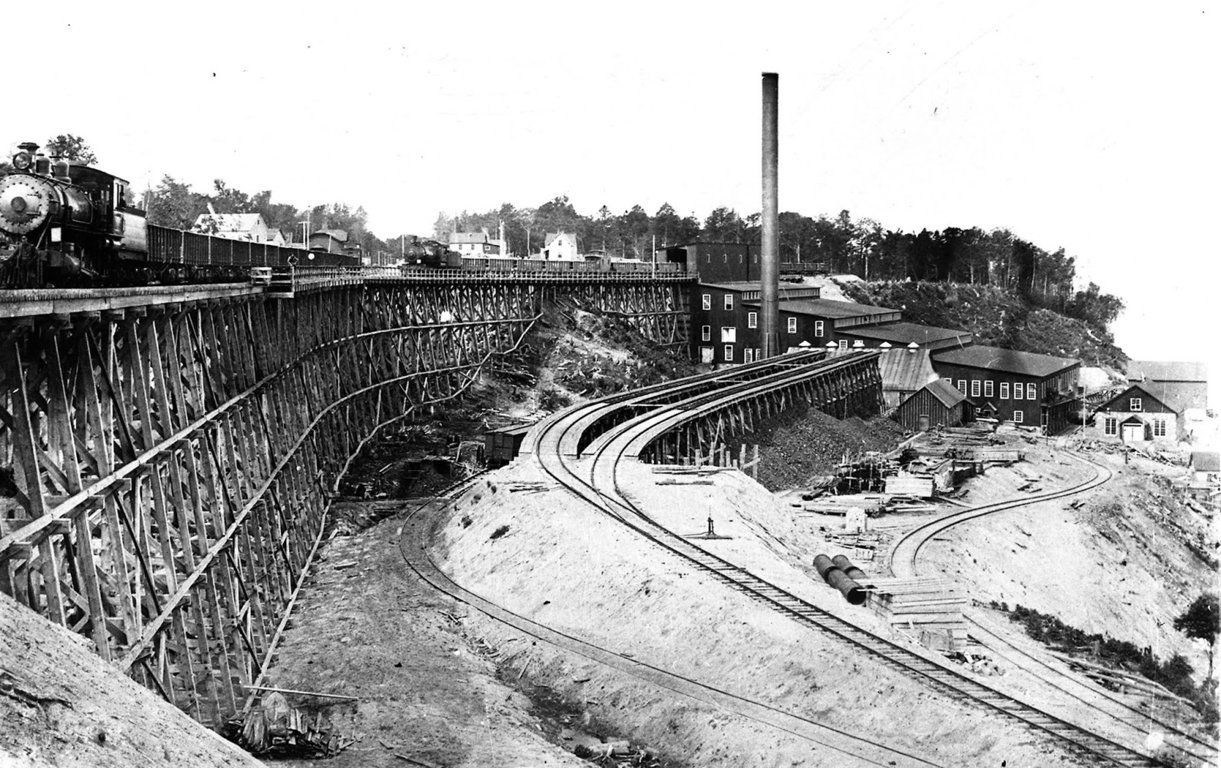- Details
- Hits: 3105
Mill: Trimountain Mill, Beacon Hill, MI
Began → Trimountain Mill → Closed
Operated for 14 years.
From: 1902
Owned by: Tri-Mountain Copper Company.
Produced: Refined copper ore.
Method: 4 steam powered stamps producing up to 2,500 tons of refined copper daily.
Railroad connection: Copper Range railroad via their Freda branch.
Until: 1916 (burned down)
Lifetime Production:

Photo Info: A view of the stamp mill along Lake Superior. Note the railroad access on several levels. The top level was for delivery of copper rock into the plant. The double track trestle lower and to the right was for the delivery of coal for the boiler. The other tracks were likely for collecting refined rock, for delivery to a smelter.
Notes
Trimountain Mill was located at Beacon Hill, northeast of Freda on Lake Superior. Operations were started here in 1902. The mill was constructed with a steel frame. This mill had a "step-down" process with raw ore loaded into the top, and the ore processed as it went lower into Lake Superior. Refined ore then went to a smelter and tailings out into the lake.
The land for this mill was donated to the Trimountain Company by the Copper Range Company in exchange for a traffic agreement with the Copper Range railroad. [CRR]
Unlike the nearby Baltic and Atlantic mills, the Trimountain mill drew water in from Lake Superior.
The Trimountain Mill had a framed railroad trestle, 78 feet long, built in 1902.
The Trimountain Mill had four Nordberg compound steam stamps, each handling up to 2,500 tons of stamp rock daily. The site also had machine, blacksmith and carpenter shops, an electric light plant, and houses on the Beacon Hill townsite. [HAL][SBM]
The mill burned completely in March, 1916 and output from the Trimountain Mine was diverted to the nearby Baltic Mill for processing. [MCI-1916]
The Copper Range railroad had a 78' framed trestle at the Trimountain mill, built in 1902.
Time Line
1902. This mill was created. [MIS-2022-W]
1905. The roof of the Trimountain mill is being raised, preparatory to the necessary changes in connection with the installation of the steeple-compound stamps, which were contracted for several months ago. The mine is now supplying 2,000 tons of rock daily, which is well up to the capacity of the mill, but with the completion of the improvements the four stamps will be capable of crushing 3,000 tons of rock every 24 hours. [DFP-1905-0402]
1916. March. The mill burned.
Bibliography
The following sources are utilized in this website. [SOURCE-YEAR-MMDD-PG]:
- [AAB| = All Aboard!, by Willis Dunbar, Eerdmans Publishing, Grand Rapids ©1969.
- [AAN] = Alpena Argus newspaper.
- [AARQJ] = American Association of Railroads Quiz Jr. pamphlet. © 1956
- [AATHA] = Ann Arbor Railroad Technical and Historical Association newsletter "The Double A"
- [AB] = Information provided at Michigan History Conference from Andrew Bailey, Port Huron, MI

